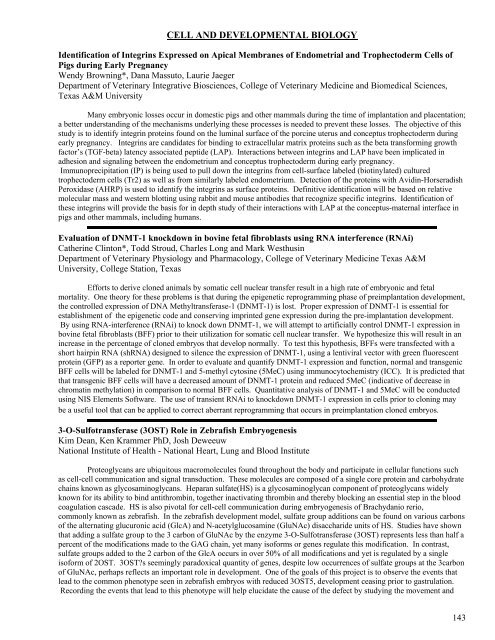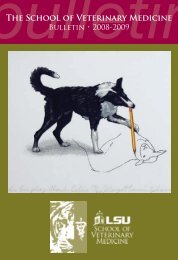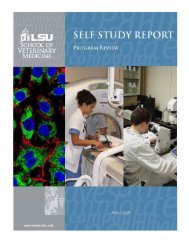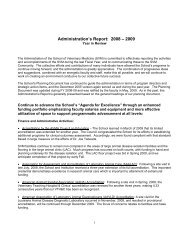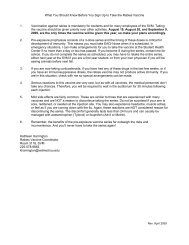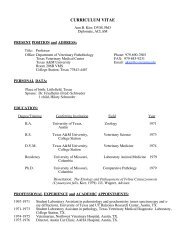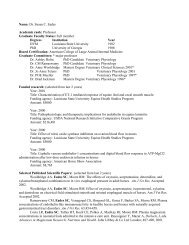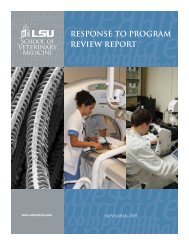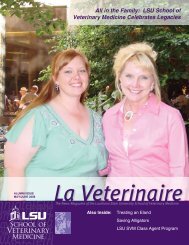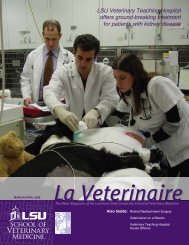2006 merck/merial - School of Veterinary Medicine - Louisiana State ...
2006 merck/merial - School of Veterinary Medicine - Louisiana State ...
2006 merck/merial - School of Veterinary Medicine - Louisiana State ...
Create successful ePaper yourself
Turn your PDF publications into a flip-book with our unique Google optimized e-Paper software.
CELL AND DEVELOPMENTAL BIOLOGYIdentification <strong>of</strong> Integrins Expressed on Apical Membranes <strong>of</strong> Endometrial and Trophectoderm Cells <strong>of</strong>Pigs during Early PregnancyWendy Browning*, Dana Massuto, Laurie JaegerDepartment <strong>of</strong> <strong>Veterinary</strong> Integrative Biosciences, College <strong>of</strong> <strong>Veterinary</strong> <strong>Medicine</strong> and Biomedical Sciences,Texas A&M UniversityMany embryonic losses occur in domestic pigs and other mammals during the time <strong>of</strong> implantation and placentation;a better understanding <strong>of</strong> the mechanisms underlying these processes is needed to prevent these losses. The objective <strong>of</strong> thisstudy is to identify integrin proteins found on the luminal surface <strong>of</strong> the porcine uterus and conceptus trophectoderm duringearly pregnancy. Integrins are candidates for binding to extracellular matrix proteins such as the beta transforming growthfactor’s (TGF-beta) latency associated peptide (LAP). Interactions between integrins and LAP have been implicated inadhesion and signaling between the endometrium and conceptus trophectoderm during early pregnancy.Immunoprecipitation (IP) is being used to pull down the integrins from cell-surface labeled (biotinylated) culturedtrophectoderm cells (Tr2) as well as from similarly labeled endometrium. Detection <strong>of</strong> the proteins with Avidin-HorseradishPeroxidase (AHRP) is used to identify the integrins as surface proteins. Definitive identification will be based on relativemolecular mass and western blotting using rabbit and mouse antibodies that recognize specific integrins. Identification <strong>of</strong>these integrins will provide the basis for in depth study <strong>of</strong> their interactions with LAP at the conceptus-maternal interface inpigs and other mammals, including humans.Evaluation <strong>of</strong> DNMT-1 knockdown in bovine fetal fibroblasts using RNA interference (RNAi)Catherine Clinton*, Todd Stroud, Charles Long and Mark WesthusinDepartment <strong>of</strong> <strong>Veterinary</strong> Physiology and Pharmacology, College <strong>of</strong> <strong>Veterinary</strong> <strong>Medicine</strong> Texas A&MUniversity, College Station, TexasEfforts to derive cloned animals by somatic cell nuclear transfer result in a high rate <strong>of</strong> embryonic and fetalmortality. One theory for these problems is that during the epigenetic reprogramming phase <strong>of</strong> preimplantation development,the controlled expression <strong>of</strong> DNA Methyltransferase-1 (DNMT-1) is lost. Proper expression <strong>of</strong> DNMT-1 is essential forestablishment <strong>of</strong> the epigenetic code and conserving imprinted gene expression during the pre-implantation development.By using RNA-interference (RNAi) to knock down DNMT-1, we will attempt to artificially control DNMT-1 expression inbovine fetal fibroblasts (BFF) prior to their utilization for somatic cell nuclear transfer. We hypothesize this will result in anincrease in the percentage <strong>of</strong> cloned embryos that develop normally. To test this hypothesis, BFFs were transfected with ashort hairpin RNA (shRNA) designed to silence the expression <strong>of</strong> DNMT-1, using a lentiviral vector with green fluorescentprotein (GFP) as a reporter gene. In order to evaluate and quantify DNMT-1 expression and function, normal and transgenicBFF cells will be labeled for DNMT-1 and 5-methyl cytosine (5MeC) using immunocytochemistry (ICC). It is predicted thatthat transgenic BFF cells will have a decreased amount <strong>of</strong> DNMT-1 protein and reduced 5MeC (indicative <strong>of</strong> decrease inchromatin methylation) in comparison to normal BFF cells. Quantitative analysis <strong>of</strong> DNMT-1 and 5MeC will be conductedusing NIS Elements S<strong>of</strong>tware. The use <strong>of</strong> transient RNAi to knockdown DNMT-1 expression in cells prior to cloning maybe a useful tool that can be applied to correct aberrant reprogramming that occurs in preimplantation cloned embryos.3-O-Sulfotransferase (3OST) Role in Zebrafish EmbryogenesisKim Dean, Ken Krammer PhD, Josh DeweeuwNational Institute <strong>of</strong> Health - National Heart, Lung and Blood InstituteProteoglycans are ubiquitous macromolecules found throughout the body and participate in cellular functions suchas cell-cell communication and signal transduction. These molecules are composed <strong>of</strong> a single core protein and carbohydratechains known as glycosaminoglycans. Heparan sulfate(HS) is a glycosaminoglycan component <strong>of</strong> proteoglycans widelyknown for its ability to bind antithrombin, together inactivating thrombin and thereby blocking an essential step in the bloodcoagulation cascade. HS is also pivotal for cell-cell communication during embryogenesis <strong>of</strong> Brachydanio rerio,commonly known as zebrafish. In the zebrafish development model, sulfate group additions can be found on various carbons<strong>of</strong> the alternating glucuronic acid (GlcA) and N-acetylglucosamine (GluNAc) disaccharide units <strong>of</strong> HS. Studies have shownthat adding a sulfate group to the 3 carbon <strong>of</strong> GluNAc by the enzyme 3-O-Sulfotransferase (3OST) represents less than half apercent <strong>of</strong> the modifications made to the GAG chain, yet many is<strong>of</strong>orms or genes regulate this modification. In contrast,sulfate groups added to the 2 carbon <strong>of</strong> the GlcA occurs in over 50% <strong>of</strong> all modifications and yet is regulated by a singleis<strong>of</strong>orm <strong>of</strong> 2OST. 3OST?s seemingly paradoxical quantity <strong>of</strong> genes, despite low occurrences <strong>of</strong> sulfate groups at the 3carbon<strong>of</strong> GluNAc, perhaps reflects an important role in development. One <strong>of</strong> the goals <strong>of</strong> this project is to observe the events thatlead to the common phenotype seen in zebrafish embryos with reduced 3OST5, development ceasing prior to gastrulation.Recording the events that lead to this phenotype will help elucidate the cause <strong>of</strong> the defect by studying the movement and143


